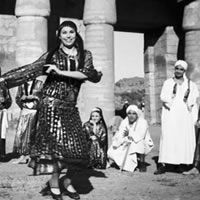During my years teaching, I felt that it was too late to do anything about what I was seeing and hearing, and just let it be. Today, the huge number of schools and dancers found all over the world are still receiving misinformation and the confusion continues. However, a good number of dancers and teachers from different countries around the world, sensed the lack of proper information, and have showed an eagerness to understand, and learn more about what they have been taught. Very few understood the difference between traditional or indigenous dance and theater dance. This has encouraged me to start writing about what I have experienced and learned.
Mahmoud Reda pioneered an entire dance genre that embraced many styles with a large vocabulary of movements. In the mid sixties, I travelled with Mahmoud Reda and a few charter members of the troupe on field trips to a number of provinces in Egypt. His aim was not to document the indigenous dances for an ethnographic purpose, nor to accurately present them on stage. In search for inspirations, his primary reason was to collect material for his forthcoming performances. His adaptations were never meant to be literal replicas of the indigenous dances that he witnessed and documented. He focused on the different qualities of movement and stressed the unique characteristics of each indigenous dance event, modifying and developing, its potentials, while preserving the essence and characteristic of each.
Mahmoud Reda was a dancer and choreographer, with a keen kinetic awareness. He was endowed with a sense of artistic discrimination that allowed him to create a theater dance genre that was culturally relevant to the Egyptians. He introduced all the possible variations and deviations that he felt could be the natural outcome of their movement qualities, posture and stance. Through these choreographies he merged the movement traits with innovative dance steps. In this way dance grew out of non-dance movement. With his talent, he was able to introduce the first theater dance genre ever known to Egypt. A Dance that was unique to the Reda Troupe.
Dance of the Fallaheen
Mahmoud Reda’s Dance of the Fallaheen is an example of how believable our presentations were. The types of dance that took place in the Nile Delta region, took place in festivities such weddings, engagements and other occasions. Women would usually dance indoors. A woman would wrap her waist, thrusts and wriggle her hips, while the women sang and clapped their hands. On the other hand, men danced with Al ‘Assayah, (stick dance that originated in Upper Egypt). Some times a professional dancer ghaziyyah and her musicians would be brought to entertain the guests. Some times there would be an effeminate man who danced like a woman.
In the frequent sittings that took place before the actual and physical dance performances of the Reda Troup, Mahmoud Reda and his co- founders talked about the Fallaheen of the Delta region and the potentials they offered for dance. They discussed how the Fallah (singular, male Egyptian peasant) exerted his energy, and used his body when he worked in the fields, tilling the land or harvesting his crops. His mannerisms, gestures and gesticulation were also noted. As for the Fallahah (singular female Egyptian peasant), she was already known for her stately posture and demeanor as she balanced her Ballas (a typical Egyptian water Urn) on her head. The choice of movement for stage was a natural outcome of how she moved, and handled herself.
Soon after presenting our dances to the public, every Governorate in Egypt began to have its own folk dance group. Schools and Universities were presenting dances of the fellaheen as best as they could. Today, after more than 50 years later, everyone actually believes that this is the way the Fallaheen of Egypt dance.
***
Copyright 2018 Farida Fahmy






